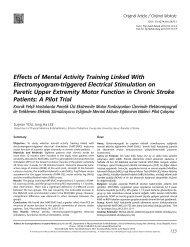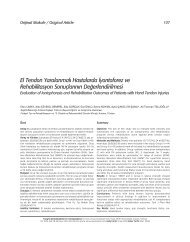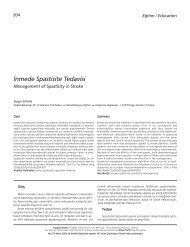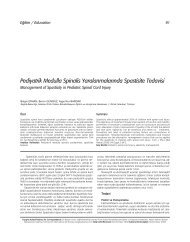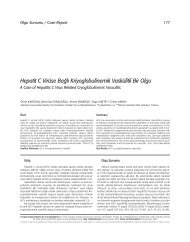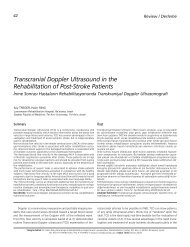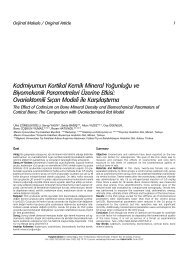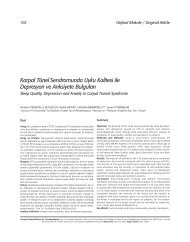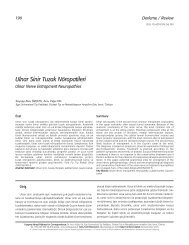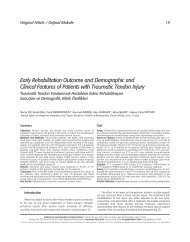Bardet-Biedl Syndrome Associated With Brachial Amyotrophy
Bardet-Biedl Syndrome Associated With Brachial Amyotrophy
Bardet-Biedl Syndrome Associated With Brachial Amyotrophy
Create successful ePaper yourself
Turn your PDF publications into a flip-book with our unique Google optimized e-Paper software.
Case Report / Olgu Sunumu<br />
DO I: 10.4274/tftr.26918<br />
<strong>Bardet</strong>-<strong>Biedl</strong> <strong>Syndrome</strong> <strong>Associated</strong> <strong>With</strong> <strong>Brachial</strong> <strong>Amyotrophy</strong><br />
and Cerebral and Cerebellar Atrophy: A Case Report<br />
Brakiyal Amyotrofi, Serebral ve Serebellar Atrofi ile İlişkili <strong>Bardet</strong>-<strong>Biedl</strong> Sendromu: Bir Olgu Sunumu<br />
Makbule Özge YILDIRIM, Canan ÇELİK, Mine TEZYÜREK*<br />
Ankara Physical Medicine and Rehabilitation Education and Research Hospital, Ankara, Turkey<br />
*Fizyomed Physical Medicine and Rehabilitation Center, Ankara, Turkey<br />
Sum mary<br />
<strong>Bardet</strong>-<strong>Biedl</strong> syndrome is an autosomal recessive disorder characterized by<br />
rod-cone dystrophy of the retina, mental retardation, obesity, polydactyly<br />
and hypogonadism, as well as renal abnormalities. Laurence-Moon<br />
syndrome, as a distinct entity, is rare and the features include spastic<br />
paraplegia in the absence of polydactyly, obesity, and renal involvement,<br />
though cranial symptoms are very unusual. We aimed to report a patient<br />
who exhibited characteristic features of <strong>Bardet</strong>-<strong>Biedl</strong> syndrome in addition<br />
to brachial amyotrophy, and cerebellar and cerebral cortical atrophy.<br />
Turk J Phys Med Re hab 2011;57 Suppl 2: 345-7.<br />
Key Words: <strong>Bardet</strong>-<strong>Biedl</strong> syndrome, brachial amyotrophy, cerebellar and<br />
cerebral cortical atrophy<br />
Introduction<br />
<strong>Bardet</strong>-<strong>Biedl</strong> syndrome (BBS) is a rare, autosomal recessive<br />
disorder characterized by cardinal features including rod-cone<br />
dystrophy of the retina (sometimes called retinitis pigmentosa),<br />
mental retardation, obesity, polydactyly, hypogonadism (in males<br />
only), and renal abnormalities. In addition, disordered speech or<br />
speech delay, syndactyly, brachydactyly, cataracts, astigmatism,<br />
strabismus, developmental delay, nephrogenic diabetes insipidus,<br />
ataxia, mild spasticity, diabetes mellitus, dental crowding,<br />
hypodontia, and high arched palate can be seen as secondary<br />
features. For the diagnosis, 4 primary or 3 primary and 2 secondary<br />
criteria are required (1). Formerly, BBS was grouped with Lawrence-<br />
Özet<br />
345<br />
<strong>Bardet</strong>-<strong>Biedl</strong> sendromu, retinada çubuk-koni distrofisi, mental retardasyon,<br />
obezite, polidaktili, hipogonadizm ve renal bozukluklarla karakterize<br />
otozomal resesif bir hastalıktır. Laurence-Moon sendromu ayrı bir antite<br />
olarak daha nadirdir ve özelliklerinde spastik parapleji mevcuttur ve<br />
polidaktili, obezite ve renal tutulum yoktur, bununla birlikte kraniyal<br />
semptomlar nadirdir. Biz <strong>Bardet</strong>-<strong>Biedl</strong> sendromu’nun karakteristik<br />
özelliklerini sergileyen ek olarak brakiyal amyotrofi, serebellar ve serebral<br />
kortikal atrofisi olan bir olguyu sunmayı amaçladık. Türk Fiz T›p Re hab Derg<br />
2011;57 Özel Sayı 2: 345-7.<br />
Anah tar Ke li me ler: <strong>Bardet</strong>-<strong>Biedl</strong> sendromu, brakiyal amiyotrofi, serebellar<br />
ve serebral kortikal atrofi<br />
Moon syndrome, which includes spastic paraparesis, but not obesity<br />
and polydactyly, though they are now considered separate entities<br />
(2). A review of the literature revealed only a few scattered reports<br />
of cerebellar vermis hypoplasia, and temporal and parietal<br />
hypoplasia. In this case report, we described a patient with features<br />
of BBS who exhibited brachial amyotrophy, and cerebellar and<br />
temporal lobe hypoplasia.<br />
Case Presentation<br />
A 34-year-old male patient presented to our outpatient clinic<br />
because of weakness and numbness in his left arm that began one<br />
month earlier. One week before presentation, his complaints were<br />
Ad dress for Cor res pon den ce/Ya z›fl ma Ad re si: Makbule Özge Yıldırım, MD. Ankara Physical Medicine and Rehabilitation Education and Research Hospital, Ankara, Turkey<br />
Phone: +90 312 310 32 30 E-mail: ozgebarazi@gmail.com<br />
©Tur kish Jo ur nal of Physi cal Me di ci ne and Re ha bi li ta ti on, Pub lis hed by Ga le nos Pub lis hing. / © Tür ki ye Fi zik sel Tıp ve Re ha bi li tas yon Der gi si, Ga le nos Ya yı ne vi ta ra fın dan ba sıl mış tır.
346<br />
Yıldırım et al.<br />
<strong>Bardet</strong>-<strong>Biedl</strong> <strong>Syndrome</strong> <strong>With</strong> Cerebral-Cerebellar Atrophy<br />
accompanied by shoulder, elbow, and wrist pain. The patient’s<br />
history revealed an extra digit on his right foot, poor vision, and<br />
mental retardation since birth. He was the ninth child of seconddegree<br />
consanguineous parents. The family history showed that his<br />
mother had two stillbirths and that a brother died from leukemia at<br />
the age of 44 years. His living 45-year-old brother had obesity,<br />
retinitis pigmentosa, polydactyly, and infertility problems.<br />
Additionally, the patient had four healthy sisters and two healthy<br />
brothers. Because of socioeconomic problems, we could not<br />
examine his brother with the history of obesity, retinitis pigmentosa,<br />
polydactyly, and infertility problems.<br />
On physical examination of the patient, obesity, strabismus, poor<br />
vision, micrognathia, facial dysmorphism, dental anomalies (high<br />
arched palate, hypodontia, small teeth), and polydactyly were<br />
observed. He was not able to fixate on or visually follow objects, and<br />
there was only a blink response to direct light during his ocular<br />
examination. Moderate mental retardation was noted.<br />
Neuromuscular examination revealed motor deficits. Shoulder<br />
and elbow 4/5, wrist 3/5, flexion of fingers 3/5, extension of fingers<br />
2/5, and abduction and adduction of fingers were 1/5 in his left arm.<br />
No motor deficit was detected in the other three extremities. Tendon<br />
reflexes of the upper extremities were brisker on the left side than on<br />
the right. In the lower extremities, bilateral patella reflexes were<br />
absent and Achilles reflexes were normal. Plantar response was<br />
extensor in the left lower limb. Severe sensory impairment (touch and<br />
pinprick) of the left upper extremity, such as hypoesthesia in C6 and<br />
T1, anesthesia in C7, and C8 dermatomes, was observed. In the<br />
other three extremities, sensory examination was normal. In all<br />
extremities proprioceptive sensory joint movement and position was<br />
unaffected. Atrophy of the thenar and hypothenar eminence muscles<br />
was noted. At the cerebellar system examination, horizontal<br />
nystagmus was positive. There was no asymmetry in pupillary size,<br />
but both pupils were unresponsive to light. Moreover, bilateral loss of<br />
Figure 1. Sagittal T1-weighted image demonstrating atrophy in the<br />
cerebellar vermis.<br />
Turk J Phys Med Re hab 2011;57 Suppl 2; 345-7<br />
Türk Fiz T›p Re hab Derg 2011;57 Özel Sayı 2; 345-7<br />
vision and absence of palatal reflexes were observed on cranial nerve<br />
examination.<br />
There was no pathological finding of the genitourinary system,<br />
except for hypospadias.<br />
Laboratory analysis included a complete blood cell count, and<br />
measurement of electrolytes, serum glucose, and lipid levels, renal<br />
and liver function tests, and gonadal hormone tests, all of which<br />
were within normal limits, except for high blood triglyceride level.<br />
Upper and lower abdominal ultrasonography (US) showed normal<br />
kidneys and normal findings, except grade II hepatosteatosis.<br />
Figure 2. Transverse T2-weighted image showing peripheral sulcal<br />
dilation (according to cortical atrophy in the temporo-frontoparietal<br />
lobes of the right cerebral hemisphere).<br />
Figure 3. T1-weighted frontal image revealed atrophy in the right<br />
temporal lobe.
Turk J Phys Med Re hab 2011;57 Suppl 2; 345-7<br />
Türk Fiz T›p Re hab Derg 2011;57 Özel Sayı 2; 345-7<br />
Electroneuromyography (ENMG) of the left upper limb revealed<br />
severe partial degeneration and regeneration of the inferior trunks,<br />
and mild axonal degeneration of the superior and middle trunks of the<br />
brachial plexus. Brain magnetic resonance imaging (MRI) showed<br />
atrophy in the cerebellar vermis (Figure 1), chronic lacunar infarct in<br />
the inferior part of the right cerebellar hemisphere, peripheral sulcal<br />
dilation (according to cortical atrophy in the temporo-fronto-parietal<br />
lobes of the right cerebral hemisphere) (Figure 2), contrast enhanced<br />
cortical and subcortical two lesions (2.5 and 5 cm in diameters) in a<br />
gyral pattern in the right occipitoparietal lobe, and atrophy in the right<br />
temporal lobe (Figure 3).<br />
Because of strabismus and poor vision, which we diagnosed in<br />
our examination, we asked for ophthalmology consultation and<br />
bilateral loss of vision and retinitis pigmentosa also diagnosed by<br />
ophthalmologists.<br />
After taking all these findings into consideration, a diagnosis of<br />
BBS seemed likely. <strong>Brachial</strong> amyotrophy was suggested by ENMG<br />
findings, and cerebellar and cerebral cortical atrophy was suggested<br />
by neurological examination and MRI.<br />
Discussion<br />
BBS is a rare, autosomal recessive disorder characterized by<br />
clinical and genetic heterogeneity. Polydactyly is most frequently<br />
seen as a supernumerary digit on the hands and/or feet, and our<br />
patient exhibited polydactyly on the right foot (3,4).<br />
Our patient presented with the primary features of BBS; obesity,<br />
polydactyly, learning difficulties, hypogonadism, and retinitis<br />
pigmentosa, as well as secondary features, such as speech delay,<br />
strabismus, hypodontia and high arched palate. However, he also<br />
exhibited neurological findings, which included cerebellar atrophy<br />
and cortical atrophy in the temporo-fronto-parietal lobes. There are<br />
only a few case reports in the literature documenting cerebellar<br />
atrophy in association with either the <strong>Bardet</strong>-<strong>Biedl</strong> or Laurence-<br />
Moon-<strong>Bardet</strong>-<strong>Biedl</strong> (LMBB) phenotype (5,6). The other<br />
neuroimaging findings reported in the literature in patients with<br />
LMBB include cerebral cortical atrophy, and hypo thalamic and<br />
pituitary abnormalities (7,8).<br />
Our patient had weakness, numbness, and motor and sensory<br />
deficits in his left arm, and ENMG studies showed brachial<br />
amyotrophy, findings, which have not been previously reported in<br />
the literature. This work, therefore, is the first to report brachial<br />
amyotrophy in a BBS patient.<br />
The clinical findings in families of individuals affected by BBS are<br />
highly variable, and there are no consistent phenotypic features. BBS<br />
Yıldırım et al.<br />
<strong>Bardet</strong>-<strong>Biedl</strong> <strong>Syndrome</strong> <strong>With</strong> Cerebral-Cerebellar Atrophy<br />
is rather rare, but it is considered that the syndrome is often<br />
misdiagnosed or undiagnosed and there are cases that have been<br />
diagnosed after the age of 50 years (9). In a review, Lannello and coworkers<br />
(9) mentioned that in addition to well-recognized features<br />
of this disorder (i.e. obesity, retinal dystrophy with compromised<br />
visual acuity, mental retardation, polydactyly and brachydactyly, and<br />
moderate renal failure), also some alterations have been occasionally<br />
described in homozygous BBS patients, such as insulin-resistant type<br />
2 diabetes mellitus and hypertension, as well as additional disorders,<br />
such as hyperfibrinogenemia, hyperuricemia, thrombophilia and/or<br />
increased vascular risk. They also suggested these factors to be<br />
included as possible other characteristics of BBS. In our opinion, all<br />
these factors which increase the vascular risk, can cause<br />
cerebrovascular diseases in patients with BBS and the management<br />
of these patients should contain neurological evaluation.<br />
In conclusion, although very rare, neurological involvement can<br />
be seen in patients with BBS. Therefore these patients require<br />
neurological examination and rehabilitation of those problems. This<br />
study is also the first to report brachial amyotrophy in a BBS patient.<br />
References<br />
347<br />
1. Katsanis N, Lupski JR, Beales PL. Exploring the molecular basis of<br />
<strong>Bardet</strong>-<strong>Biedl</strong> syndrome. Hum Mol Genet 2001;10:2293-9.<br />
2. Ertörer ME, Bakıner OS, Pelit A, Noyan T, Güvener N. <strong>Bardet</strong>-<strong>Biedl</strong><br />
syndrome presenting with Metabolic syndrome and situs inversus<br />
totalis during chilhood. The Endocrinologist 2006;16:248-9.<br />
3. Riise R. Laurence-Moon-<strong>Bardet</strong>-<strong>Biedl</strong> syndrome. Clinical<br />
electrophysiological and genetic aspects. Acta Ophthalmol Scand<br />
1998;226(Suppl):5-28.<br />
4. Green JS, Parfrey PS, Harnett JD, Farid NR, Cramer BC, Johnson G, et<br />
al. The cardinal manifestations of <strong>Bardet</strong>-<strong>Biedl</strong> syndrome, a form of<br />
Laurence-Moon-<strong>Biedl</strong> syndrome. N Engl J Med 1989;321:1002-9.<br />
5. Kowal P, Sikora G: Incomplete <strong>Bardet</strong>-<strong>Biedl</strong> syndrome associated<br />
with cerebellar ataxia. Neurol Neurochir Pol 1989;23:145-8.<br />
6. Rizzo JF, Berson EL, Lassell S. Retinal and neurologic findings in the<br />
Laurence-Moon-<strong>Bardet</strong>-<strong>Biedl</strong> phenotype. Ophthalmology<br />
1986;93:1452-6.<br />
7. Baskin E, Kayıran SM, Oto S, Alehan F, Agildere AM, Saatçi U.<br />
Cerebellar vermis hypoplasia in a patient with <strong>Bardet</strong>-<strong>Biedl</strong><br />
syndrome. J Child Neurol 2002;17:385-7.<br />
8. Soliman AT, Rajab A, AlSami I, Asfour MG. Empty sellae, impaired<br />
testosteron secretion, and defective hypothalamic-pituitary growth<br />
and gonadal axes in children with <strong>Bardet</strong>-<strong>Biedl</strong> syndrome.<br />
Metabolism 1996;45:1230-4.<br />
9. Lanello S, Bosco P, Cavaleri A, Camuto M. A review of the literature<br />
of <strong>Bardet</strong>-<strong>Biedl</strong> disease and report of three cases associated with<br />
metabolic syndrome and diagnosed after the age of fifthy. Obesity<br />
Reviews 2002;3:123-35.



